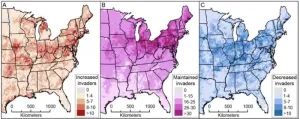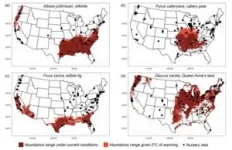(Press-News.org) AMHERST, Mass. – Researchers at the University of Massachusetts Amherst recently published a pair of papers that, together, provide the most detailed maps to date of how 144 common invasive plants species will react to 2° Celsius of climate change in the eastern U.S., as well as the role that garden centers currently play in seeding future invasions. Together, the papers, published in Diversity and Distributions and BioScience, and the publicly available maps, which track species at the county level, promise to give invasive species managers in the U.S. the tools they need to proactively coordinate their management efforts and adapt now for tomorrow’s warmer climate.
Mapping Future Abundance
One of the major hurdles in addressing the threat of invasive species is in determining when and where a species crosses the line from being non-native to invasive. A single occurrence of, say, purple loosestrife, does not an invasion make. What invasive plant managers need to know is where a species is likely to take over, outcompeting native plants and altering the ecosystem.
Or, as Bethany Bradley, professor of environmental conservation at UMass Amherst and the senior author of both papers puts it, “managers have very few resources to control invasions, so we don’t want to waste time focusing on species unlikely to become invasive in a given area. But the question of what will become invasive and where has been surprisingly tricky to answer.”
“If we can proactively identify these species and the regions they are most likely to become abundant in as the climate warms, then we can head-off a major ecological threat before it’s too late,” adds Annette Evans, a postdoctoral fellow at UMass Amherst’s Northeast Climate Adaptation Science Center and lead author of the paper on abundance and future invasive hotspots.
To do so, the team combed through 14 current invasive species databases compiled by hundreds of natural resource managers in order to first pinpoint which species are currently abundant and where, geographically, those abundance hotspots occur. They focused on the eastern U.S. (east of the 100th meridian, which runs from the middle of North Dakota through the center of Texas—a follow-up paper will focus on the western U.S.) and discovered that the hottest hotspots are around the Great Lakes, the mid-Atlantic, and along the northeastern coasts of Florida and Georgia. Each of these regions has the right mix of conditions to currently support abundant populations of more than 30 different invasive plants.
They then ran their data on 144 plants through a series of models that predicted where the hotspots would occur under 2° Celsius of warming.
What they discovered is that most of the species will shift their ranges to the northeast by an average of 213 kilometers, a trend also reflected in shifts to abundance hotspot locations. In some states, warming temperatures will make currently unsuitable areas conducive for abundant infestations of up to 21 new plant species, and the range-shifting could exacerbate the effects of up to 40 currently abundant invasives. On the other hand, 62% of currently abundant invasive species will see a decrease in habitat for large populations in the eastern U.S.
But statistics aren’t enough. “We’ve created something even more user-friendly,” says Evans: a series of publicly available range maps for individual species, which can help plant managers triage which plants most need their attention, as well as state-specific watch lists.
How plant nurseries could seed invasion
“When people think of how invasive plant species spread, they might assume species are moving because of birds or the wind dispersing seeds,” says Evelyn M. Beaury, lead author of the paper on horticulture and invasive species, as well as a postdoctoral researcher at Princeton who completed this research as an extension to her graduate studies at UMass Amherst. “But commercial nurseries that sell hundreds of different invasives are actually the primary pathway of invasive plant introduction.”
Though researchers have long known that invasives are linked to the horticulture trade, Beaury and her co-authors, including Evans and Bradley, wondered how often invasives are sold in the same area in which they are abundant? And how might nurseries be exacerbating the problem of climate-driven invasion?
It turns out that the answer to both questions is: a lot.
Using a case study of 672 nurseries around the U.S. that sell a total of 89 invasive plant species, and then running the results through the same models that the team used to predict future hotspots, Beaury and her co-authors found that nurseries are currently sowing the seeds of invasion for more than 80% of the species studied. If left unchecked, the industry could facilitate the spread of 25 species into areas that become suitable with 2°C of warming.
Furthermore, 55% of the invasive species were sold within 21 kilometers (13 miles) of an observed invasion—the median distance people across the U.S. go to buy landscaping plants. In other words, everyday gardeners who buy plants at their local nurseries could unwittingly help perpetuate invasion and associated ecological harm in their literal backyards.
“But there’s good news here,” says Beaury. “This is the first time that we have real numbers to show the connection between plant nursery sales and the spread of invasive species—including invasions that occur down the street from nurseries, as well as across state borders. Now that we have the data, we have an incredible opportunity to be proactive, to work with the industry, consumers and plant managers to think more critically about how our gardens impact U.S. ecosystems.”
The team has also put together a publicly available list of 24 commonly sold invasive plants that could increase in risk with climate change in the northeast, from butterfly bush to English ivy, to be avoided and native alternatives, such as bottlebrush buckeye and wild blue phlox.
“These two papers together make it pretty clear that not only are we facilitating current invasions through the ornamental plant trade, but we are also facilitating future climate-driven invasion,” says Bradley, “But with these papers, maps and watchlists, we can pinpoint which species are most worrisome where, both now and in the coming decades. These are important new tools in invasive plant managers’ toolboxes.”
Contacts: Bethany Bradley, bbradley@eco.umass.edu
Evelyn M. Beaury, evelynbeaury@princeton.edu
Daegan Miller, drmiller@umass.edu
END
Study finds plant nurseries are exacerbating the climate-driven spread of 80% of invasive species
New research from the University of Massachusetts Amherst is the first to precisely map role of horticulture in spreading invasives, projecting ranges under 2C of warming
2023-12-05
ELSE PRESS RELEASES FROM THIS DATE:
Jefferson Lab site grows with addition of Applied Research Center
2023-12-05
NEWPORT NEWS, VA – The Applied Research Center (ARC) is tying the knot with the U.S. Department of Energy’s Thomas Jefferson National Accelerator Facility. Today, the City of Newport News announced the transfer of the Applied Research Center to Jefferson Lab and the DOE. The announcement was made in a ribbon-tying ceremony for the facility.
“Newport News is a hub of innovation and research, thanks in large part to Jefferson Lab’s robust educational and scientific offerings,” said Newport News Mayor Phillip Jones. “Since 1985, the city has invested more than $64 ...
Texas A&M receives $1.8 million NIH grant to support bone health in people with down syndrome
2023-12-05
By Courtney Price, Texas A&M University School of Veterinary Medicine & Biomedical Sciences
Texas A&M University researchers have been awarded a $1.8 million grant from the National Institutes of Health (NIH) to study bone regeneration throughout the lifespan to ultimately benefit individuals with Down syndrome.
The new INvestigation of Co-occurring conditions across the Lifespan to Understand Down syndromE (INCLUDE) Project grant will help scientists understand whether bone regeneration holds the key to helping people ...
Membrane raft redox signaling contributes to visfatin-induced inflammation and kidney damage
2023-12-05
“[...] the exact mechanism of how obesity increases the advancement of chronic kidney disease is still uncertain.”
BUFFALO, NY- December 5, 2023 – A new research paper was published in Aging (listed by MEDLINE/PubMed as "Aging (Albany NY)" and "Aging-US" by Web of Science) Volume 15, Issue 22, entitled, “Contribution of membrane raft redox signalling to visfatin-induced inflammasome activation and podocyte injury.”
The number of obese patients with end-stage renal disease has ...
New study highlights COVID-19’s adaptive strategy for infection
2023-12-05
MINNEAPOLIS/ST. PAUL (12/05/2023) – Researchers have discovered a novel mechanism whereby the SARS-CoV-2 virus, which causes COVID-19, can vary its mode of infection in human cells. Published in the journal eLife, a team from the University of Minnesota and the Midwest Antiviral Drug Discovery (AViDD) Center found the virus can alternate between being highly infectious and avoiding detection by the immune system. This understanding is vital for grasping the virus' impact during the pandemic and for predicting its potential evolutionary developments.
The spike protein of the virus, which is crucial for attaching ...
Type 1 diabetes: B cell-derived natural antibodies suppress autoimmune pathogenesis
2023-12-05
BIRMINGHAM, Ala. – Researchers have discovered the novel mechanism that underlies a previously reported observation that infection by group A Streptococcus bacteria reduces the risk of later developing Type 1 diabetes.
The Journal of Immunology reports that vaccination of neonatal mice with group A Streptococcus promoted a clonal expansion of innate-like B cells that produce antibody against N-acetyl-D-glucosamine, or GlcNAc. GlcNAc is a derivative of glucose sugar that is found as part of the cell wall of group ...
Cable-Dunlap, Chi, Smith and Thornton named ORNL Corporate Fellows
2023-12-05
Four researchers at the Department of Energy’s Oak Ridge National Laboratory have been named ORNL Corporate Fellows in recognition of significant career accomplishments and continued leadership in their scientific fields.
Corporate Fellow is the highest recognition for members of the ORNL research staff. Paula Cable-Dunlap, Miaofang Chi, Scott Smith and Peter Thornton have been recognized by the laboratory for their standing in the international scientific community as exceptional and influential researchers and as role models and mentors among peers and early career researchers.
“Paula, Miaofang, Scott and Peter represent ...
UofL secures $6.5 million to enhance training for nursing professionals
2023-12-05
The University of Louisville has received $6.5 million through two federal grants to help increase Kentuckians’ access to health care, particularly in underserved rural and urban areas. The UofL School of Nursing will use the funds from the Health Resources and Services Administration (HRSA) to develop and implement an accelerated Licensed Practical Nurse-to-Bachelor of Science in Nursing (LPN-to-BSN) pathway in medically underserved areas of Kentucky. The second HRSA-funded project aims ...
Reverse metabolomics: new method finds biomarker for inflammatory bowel disease
2023-12-05
In recent years, microbiome research has started to shift its focus from the microbes themselves to the molecules they produce. After all, it’s these molecules that directly interact with human cells to influence a person’s health. But trying to identify which molecules are being made by a person’s microbiome is quite challenging. A typical metabolomics study can only characterize about 10% of the molecular data from a human microbiome sample.
In a new study published on December 5, 2023 in Nature, microbiome experts at University of California San Diego ...
Older organs accelerate aging in transplant recipients
2023-12-05
Most organ transplantations involve supply from older donors to younger recipients. Aging cells can become senescent, a condition in which they stop multiplying and secrete chemicals that negatively affect neighboring cells. Senescent cells accumulate in older donor organs, and have the potential to compromise transplant outcomes.
A study led by researchers from Brigham and Women’s Hospital, a founding member of the Mass General Brigham healthcare system, found that in preclinical models, transplanting older organs can trigger ...
Pregnant women are missing vital nutrients needed for them and their babies – and situation could worsen with plant-based foods
2023-12-05
Pregnant women are not getting the essential nutrients they and their babies need from modern diets say scientists, who have warned that the situation will likely worsen as more people turn to plant-based foods.
A study looking at the health of expecting mothers from high-income countries, including the UK, New Zealand and Singapore, found that 90 per cent were lacking key vitamins necessary for healthy pregnancies and the wellbeing of unborn infants.
Scientists from the University of Southampton, working with experts worldwide, surveyed more than 1,700 women and found most were missing essential nutrients found in abundance in meat and dairy products.
These included vitamins B12, B6 and ...
LAST 30 PRESS RELEASES:
Why nail-biting, procrastination and other self-sabotaging behaviors are rooted in survival instincts
Regional variations in mechanical properties of porcine leptomeninges
Artificial empathy in therapy and healthcare: advancements in interpersonal interaction technologies
Why some brains switch gears more efficiently than others
UVA’s Jundong Li wins ICDM’S 2025 Tao Li Award for data mining, machine learning
UVA’s low-power, high-performance computer power player Mircea Stan earns National Academy of Inventors fellowship
Not playing by the rules: USU researcher explores filamentous algae dynamics in rivers
Do our body clocks influence our risk of dementia?
Anthropologists offer new evidence of bipedalism in long-debated fossil discovery
Safer receipt paper from wood
Dosage-sensitive genes suggest no whole-genome duplications in ancestral angiosperm
First ancient human herpesvirus genomes document their deep history with humans
Why Some Bacteria Survive Antibiotics and How to Stop Them - New study reveals that bacteria can survive antibiotic treatment through two fundamentally different “shutdown modes”
UCLA study links scar healing to dangerous placenta condition
CHANGE-seq-BE finds off-target changes in the genome from base editors
The Journal of Nuclear Medicine Ahead-of-Print Tip Sheet: January 2, 2026
Delayed or absent first dose of measles, mumps, and rubella vaccination
Trends in US preterm birth rates by household income and race and ethnicity
Study identifies potential biomarker linked to progression and brain inflammation in multiple sclerosis
Many mothers in Norway do not show up for postnatal check-ups
Researchers want to find out why quick clay is so unstable
Superradiant spins show teamwork at the quantum scale
Cleveland Clinic Research links tumor bacteria to immunotherapy resistance in head and neck cancer
First Editorial of 2026: Resisting AI slop
Joint ground- and space-based observations reveal Saturn-mass rogue planet
Inheritable genetic variant offers protection against blood cancer risk and progression
Pigs settled Pacific islands alongside early human voyagers
A Coral reef’s daily pulse reshapes microbes in surrounding waters
EAST Tokamak experiments exceed plasma density limit, offering new approach to fusion ignition
Groundbreaking discovery reveals Africa’s oldest cremation pyre and complex ritual practices
[Press-News.org] Study finds plant nurseries are exacerbating the climate-driven spread of 80% of invasive speciesNew research from the University of Massachusetts Amherst is the first to precisely map role of horticulture in spreading invasives, projecting ranges under 2C of warming









